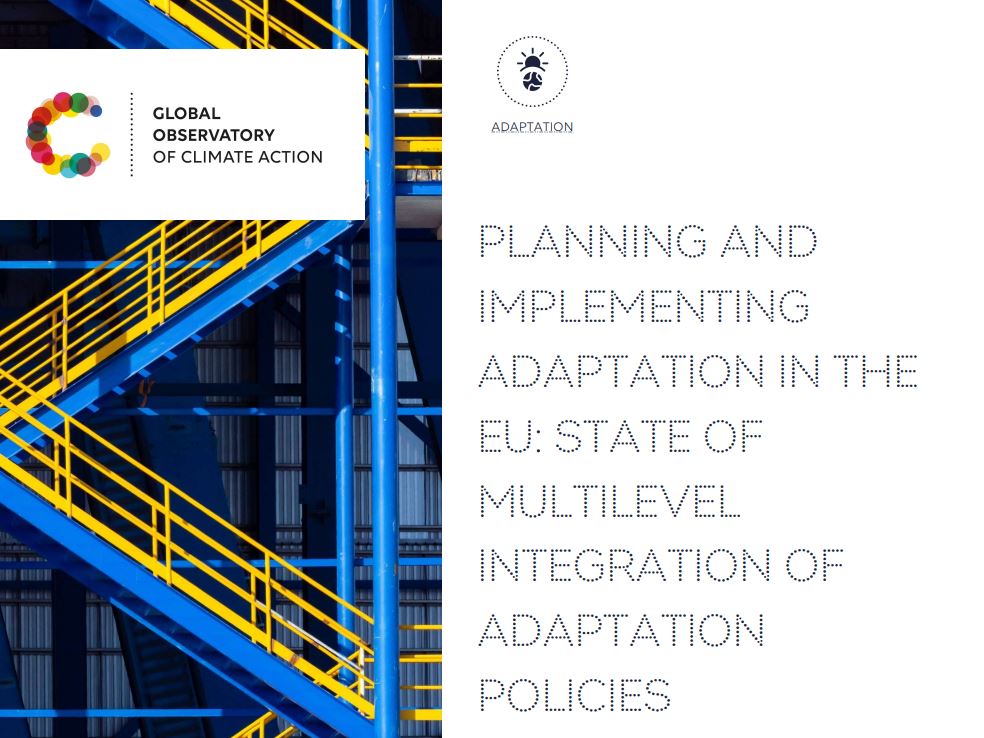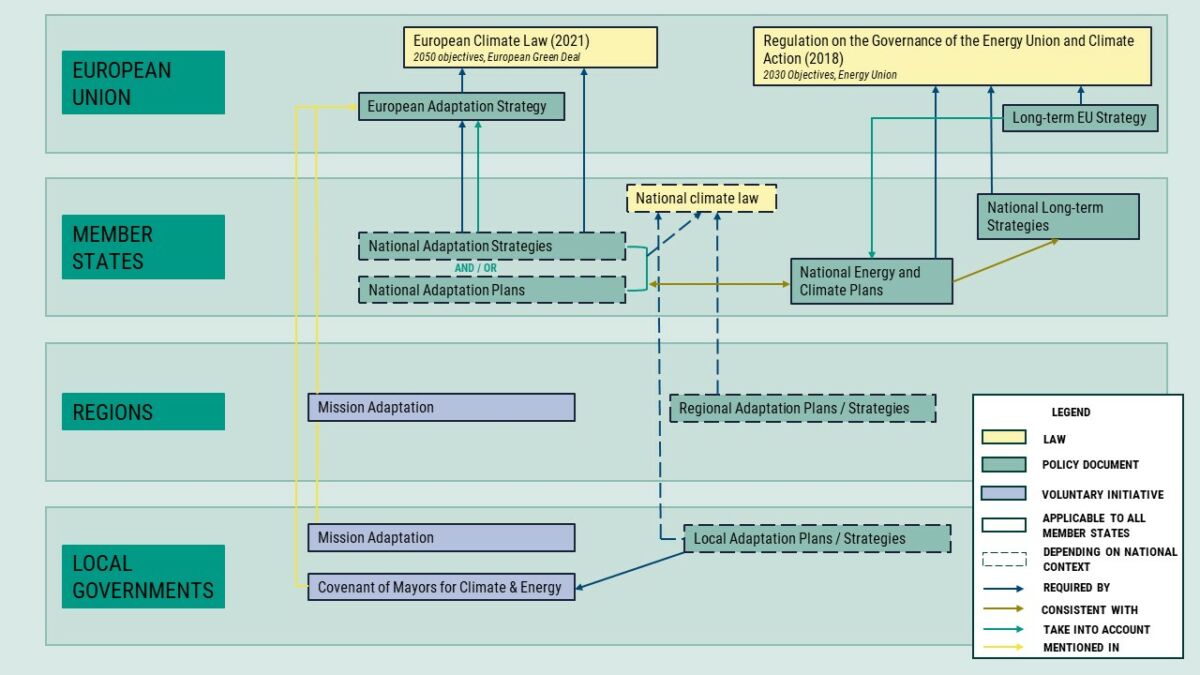The role of subnational governments in climate adaptation in Europe: Takeaways from the Observatory’s new publication
[April 2024] Based on the Observatory's new study, this article explains the multilevel policy framework for climate change adaptation in Europe. It looks at the roles and obligations of regional and local governments when it comes to adaptation, and the progress of voluntary subnational action.

Takeaways from “Planning and implementing adaptation in the EU: State of multilevel integration of adaptation policies”
Author: Tania Martha Thomas, Research Officer, Climate Chance Observatory
Date: 10 April, 2024
Summary:
- The local nature of adaptation
- The European Adaptation Strategy and policy framework
- The subnational dynamic and strong signals of voluntary action
- Regions’ role in financing adaptation
This article is based on a recent publication of the Climate Chance Observatory, titled “Planning and implementing adaptation in the EU: State of multilevel integration of adaptation policies”. Discover the publication here.
The local nature of adaptation
While the world is already at 1.1 °C of warming above the pre-industrial average, Europe is warming faster: the European Environment Agency estimates that land temperatures have increased by over 2 °C. [1] The IPCC[2] notes that the impacts of compound hazards of warming and precipitation have become more frequent, and identifies four key risks for the continent: mortality, morbidity and ecosystem changes due to heat; heat and drought stress on crops; water scarcity; and flooding and sea level rise. In this context, the need to adapt the continent to the impacts of the changing climate is more urgent than ever.
Adaptation, defined as “the process of adjustment to actual or expected climate and its effects, in order to moderate harm or exploit beneficial opportunities”,[3] is based on the hazards and vulnerabilities of a given area. It is locally-rooted or “place-based”, in that it depends on the climatic, geographic, socio-economic, and even political characteristics of a place. It also lacks a universal indicator, unlike mitigation which can be reasoned out in terms of tonnes of emissions, as there is no one-size-fits-all solution to adaptation. Here lies the importance of planning and coordinating national adaptation policies with subnational and local levels of governance.
The European Adaptation Strategy and policy framework
The current European Adaptation Strategy[4] establishes a framework that takes into account the EU, national, regional and local levels, drawing on requirements included in the 2021 European Climate Law[5] and the 2018 Regulation on the Governance of the Energy Union and Climate Action.[6] The interpretation of these three texts shows the precise roles and obligations of the national level, with a well-defined policy cycle for climate action in general, and a slightly more ambiguous one for adaptation – where there are no binding targets or timelines (figure 1).

While the Adaptation Strategy identifies Member States to be the “main implementation partners”, it calls for more systemic adaptation, prioritizing local action. The Strategy calls for improved risk assessments, and encourages national, regional, and local authorities to further develop adaptation strategies based on the latest science. The delegation to subnational levels of adaptation roles is almost entirely up to the Member States, and thus, highly variable.
Only eight Member States (nine with the entering into force of the German Adaptation Law) have “top-down” approaches to adaptation policy, where lower levels of governance are legally required to take up some kind of adaptation planning and actions. In the remaining countries, subnational adaptation is mostly “bottom-up”, driven by the voluntary action of regional and local governments.
The subnational dynamic and strong signals of voluntary action
The European Environment Agency notes that these soft, collaboration-based forms of vertical steering accompanied by supportive governance across levels are much more common than top-down regulatory approaches.[7] In these cases, support from the national levels includes policy inputs, capacity building, funding, and support for participation in national and international local government networks.
The voluntary actions of local and regional governments are very often channelled through their participation in transnational networks and initiatives, like the Covenant of Mayors or RegionsAdapt. According to the 2022 assessment by the European Covenant of Mayors carried out by the European Union Joint Research Centre (JRC)[8], 4,044 signatories from the EU-27 were committed to adaptation, of which 996 (24.6%) had submitted a complete adaptation plan. Spain, Italy and Belgium count the highest number of Covenant signatories committed to adaptation, with Belgium having the highest share of population covered by a local adaptation commitment (nearly 100%). A 2023 study[9] of 327 large- and medium-sized European cities with from 2005 to 2020 showed that 51% of them has an adaptation plan in place, though less than half of these were under a legal obligation. The study also found that plan quality has been improving over time, due also to peer-to-peer exchanges and knowledge sharing through networks.
A strong signal of the voluntary dynamic among European regions is their participation in the EU Mission Adaptation: of the 301 signatories of the Mission that were assessed in 2023, 66% had completed a risk assessment, 80% had an adaptation strategy in place, 70% had a dedicated resource-person or team for adaptation, and 66% had a dedicated regional adaptation budget.[10]
Regions’ role in financing adaptation
The regional level – despite differing in definition according to the level of decentralisation and federal structure of countries – is also key to financing and implementing adaptation policies, as the Climate Chance Observatory highlighted in 2022.[11] While Member States report facing challenges in terms of assessing the cost of adaptation and tracking finance flows to adaptation, those that report quantitative elements mentioned that a large portion of these funds came from the EU level, and that EU funding instruments helped to coordinate adaptation policies.[12]
This includes funding from a range of EU instruments like the Recovery and Resilience Facility, the LIFE Programme, Horizon Europe, the European Cohesion Policy, the European Regional Development Fund, the Cohesion Fund, the Just Transition Fund, and others. 20% of funds had to be devoted to mitigation or adaptation projects from 2014-2020, representing about 78 billion euros and up to nearly a third of the ERDF. [13] The 2021 – 2027 Multiannual Financial Framework requires that at least 25% of the European budget in climate-related expenditure. This structure of disbursements at the European level thus reinforces the important role of regions as determinants of the direction of adaptation finance flows. [14]
Local adaptation in Europe: An issue at the heart of #SCCE2024
Thus, the voluntary action of subnational levels remains essential in driving climate adaptation, in the absence of national or European obligations. While planning is advancing, the implementation of actions requires further strengthening of subnational capacities, and better coordination between and across levels of governance. The Climate Chance Europe 2024 Wallonia Summit (SCCE2024) in Liège gathered actors from all over the continent to reflect on how subnational climate adaptation actions can be reinforced; the results of these discussions are synthesized here, and included in the collective messages of the Liège Declaration, a roadmap for local and non-state actors in Europe to adapt to climate change.
References
[1] EEA (29/06/2023). Global and European temperatures. European Environment Agency.
[2] Pörtner, H.-O. et al. (2022). Climate Change 2022: Impacts, Adaptation and Vulnerability. Contribution of Working Group II to the Sixth Assessment Report of the Intergovernmental Panel on Climate Change. Cambridge University Press.
[3] Möller, V. et al (2022). Annex II: Glossary. In Pörtner, H.-O. et al. (2022). Climate Change 2022: Impacts, Adaptation and Vulnerability. Contribution of Working Group II to the Sixth Assessment Report of the Intergovernmental Panel on Climate Change. Cambridge University Press.
[4] European Commission (2021). COMMUNICATION FROM THE COMMISSION TO THE EUROPEAN PARLIAMENT, THE COUNCIL, THE EUROPEAN ECONOMIC AND SOCIAL COMMITTEE AND THE COMMITTEE OF THE REGIONS. Forging a climate-resilient Europe – the new EU Strategy on Adaptation to Climate Change. COM/2021/82 final.
[5] Regulation (EU) 2021/1119 of the European Parliament and of the Council of 30 June 2021 establishing the framework for achieving climate neutrality and amending Regulations (EC) No 401/2009 and (EU) 2018/1999 (‘European Climate Law’). [2021]. OJ L243.
[6] Regulation (EU) 2018/1999 of the European Parliament and of the Council of 11 December 2018 on the Governance of the Energy Union and Climate Action, amending Regulations (EC) No 663/2009 and (EC) No 715/2009 of the European Parliament and of the Council, Directives 94/22/EC, 98/70/EC, 2009/31/EC, 2009/73/EC, 2010/31/EU, 2012/27/EU and 2013/30/EU of the European Parliament and of the Council, Council Directives 2009/119/EC and (EU) 2015/652 and repealing Regulation (EU) No 525/2013 of the European Parliament and of the Council (Text with EEA relevance). [2018]. OJ L328.
[7] Leitner, M. et al. (2023). Is Europe on track towards climate resilience? – Status of reported national adaptation actions in 2023. Technical Paper 2/23. European Topic Centre on Climate change adaptation and LULUCF (ETC-CA).
[8] Melica, G. et al (2022). Covenant of Mayors: 2022 assessment. EUR 31291. Publications Office of the European Union.
[9] Reckien, D. et al. (2023). Quality of urban climate adaptation plans over time. npj Urban Sustainability vol. 3, 13.
[10] Directorate-Generak for Climate Action (02/2023). Analysis of information provided by the signatories of the charter of the Mission Adaptation to Climate Change. European Commission.
[11] Global Observatory of Climate Action (2022). European Regions Illustrate the Central Role of Local and Subnational Governments in a Just Transition Towards a Low-carbon Economy. Climate Chance.
[12] Leitner, M. et al. (2023). Is Europe on track…, op. cit.
[13] Dijkstra, L. (2017). My region, My Europe, Our future: The seventh report on economic, social and territorial cohesion. European Commission.
[14] Climate-ADAPT (n.d.). EU funding of adaptation. European Commission; European Environment Agency.

